Music
Trailers
DailyVideos
India
Pakistan
Afghanistan
Bangladesh
Srilanka
Nepal
Thailand
StockMarket
Business
Technology
Startup
Trending Videos
Coupons
Football
Search
Download App in Playstore
Download App
Best Collections
Technology
Challenger banks, neobanks or digital-only banks… Whatever we choose to call them, Europe — and the U.K. in particular — has more than its fair share of bank upstarts battling it out for a slice of the growing fintech pie. One of those is Tandem, co-founded by financial technology veteran Ricky Knox, who we&re excited to announce will join us at TechCrunch Disrupt Berlin.
Tandem — or the so-called &Good Bank& — has been on quite a journey this year. Most recently the bank launched a competitive fixed savings product, pitting it against a whole host of incumbent and challenger banks. It followed the launch of the Tandem credit card in February, which competes well on cash-back and FX rates when spending abroad.
Both products are part of a wider strategy where, like many other consumer-facing fintechs, Tandem wants to become your financial control centre and connect you to and offer various financial services. These are either products of its own or through partnerships with other fintech startups and more established providers.
At the heart of this is the Tandem mobile app, which acts as a Personal Finance Manager (PFM), including letting you aggregate your non-Tandem bank account data from other bank accounts or credit cards you might have, in addition to managing any Tandem products you&ve taken out. The company recently acquired fintech startup Pariti to beef up its account aggregation features.
However, what makes Tandemrecent progress all the more interesting is that it comes after a definite bump in the road last year. This saw the company temporarily lose its banking license and forced to make lay-offs following the partial collapse of a £35 million investment round from department store House of Fraser, due to restrictions on capital leaving China. The remedy was further investment from existing backers and the bold move to acquire Harrods Bank, the banking arm of the U.K.most famous luxury department store.
As you can see, there is plenty to talk about. And some. So, why not grab your ticket to Disrupt Berlin to listen to the Tandem story. The conference will take place on November 29-30.
In addition to fireside chats and panels, like this one, new startups will participate in the Startup Battlefield Europe to win the highly coveted Battlefield cup.
Ricky Knox
CEO - Co-Founder, Tandem
Ricky is a serial investor and entrepreuner. He has built five technology disruptors in fintech and telecoms, each of which also does a bit of good for the world.
Before Tandem he founded Azimo and Small World, two remittance businesses, and is managing partner of Hexagon Partners, a private equity firm. He built Tandem to be a digital bank that helps improve customers& lives with money.
Ricky has a first class degree from Bristol University and an MBA from INSEAD.
- Details
- Category: Technology
Read more: Tandem CEO will tell you why building a bank is hard at Disrupt Berlin
Write comment (94 Comments)Itnever particularly easy to raise a round of venture capital — but I think most experienced founders will tell you its not quite as bad the second or third time around, when you&ve got some experience under your belt and a track record to present to VCs.
It helps if you&re male too, at least according to all the data out there on the gender funding gap in VC.
The leadership team at OODA Health, a startup developing technology to make the U.S. healthcare payment system more efficient, is both male and experienced. But unlike most companies of that nature, OODA decided to raise money for the business only from VC firms that have at least one female leader, a solution to one of techgreatest problems that is oft suggested and rarely executed.
&‘Brotopia& really hit me hard,& OODA Health co-founder and CEO Giovanni Colella told TechCrunch.
Colella is the founder and former CEO of Castlight Health, which raised nearly $200 million in VC funding before going public on the NYSE in 2014. Co-founder and COO Seth Cohen is Castlightformer VP of sales and alliances and co-founder and CTO Usama Fayyad is the former global chief data officer at Barclays and Yahoo .
The trio ultimately landed on lead investors Annie Lamont of Oak HC/FT and Emily Melton of DFJ, both of which have joined the companyboard of directors.
&We have a responsibility of setting an example,& Colella said. &There is no machismo in what we&ve done. We are not better than you because we did it. We were blessed. We had more investors that wanted to invest than we could accommodate.&
Though the companyc-suite is occupied by men, Cohen and Colella were quick to clarify that the rest of their founding team, head of operations Julie Skaff, head of product Sophie Pinkard and director of product strategy Midori Uehara, are women.
The team began working on OODA Health last year after Colella and Cohen agreed to build something that would upend the healthcare industry. Healthcare, they realized, is at least 20 years behind the advances in financial tech.
The pair said theirreal aha moment was when they learned even insurance companies — the real laggards — are ready to be rid of the slow, futile billing and payment methods that accompany any and every doctor and hospital visit.
&The idea of submitting a claim and not knowing when you are going to get reimbursed or get a bill, that has been the same for decades,& Cohen told TechCrunch. &Imagine, today, if you took a Visa card and you went to a restaurant … and then a month later received a bill, thathow healthcare works.&
If OODA has their way, paying for a doctorvisit will be more like paying for a hotel. You&re told upfront what you owe and you work exclusively with the insurance company to make that payment. And in this idyllic future, you won&t receive an &explanation of benefits& notice in the mail as well as a bill and subsequently fall into a downward spiral of confusion, stress and frustration.
Headquartered in San Francisco, OODA has teamed with several big-name insurance providers, includingAnthem, Blue Cross Blue Shield of Arizona, Blue Shield of California, Zaffre Investments, Dignity Health and Hill Physicians to make this happen.
As far as lifting up women in VC, thatpurely been a side benefit of the overall operation.
&At the end of the day, we found two of the best investors to back us,& Cohen said.
- Details
- Category: Technology
Allplants, a London-based startup that delivers ready-made &plant-based& meals (thatvegan, to you and me), has raised £7.5 million in Series A funding. The round is led by VC firm Octopus Ventures, which was an early backer in healthy snack delivery company Graze.
Additional investors in the round include existing backer Felix Capital (which I&m told has doubled its seed investment), Swedish VC firm Otiva, unnamed partners at VerlInvest (who are participating in a personal capacity), David Milner (ex-CEO Tyrells), Simon Nixon (founder of MoneySupermarket), and video blogger Jack Harries. Allplants reckons it is the U.K.largest Series A round for a vegan company.
Based on the premise that switching to a plant-based diet is the most impactful way to reduce our environmental footprint (and improve health), Allplants has developed a delivery service that wants to make it &effortlessly easy to eat more plants&. Specifically, either as a one-off or on a subscription basis, it delivers healthy, chef-made, vegan meals, for you to reheat at home.
They are &quick frozen& to lock in freshness and the idea is that you receive six meals at a time, to serve one or two people each, making the model more scalable and delivery more cost-effective. When your food is delivered you store it in your own freezer and cook/eat as needed, before your next order.
Since being founded in 2017 by brothers Jonathan and Alex Petrides, Allplants says it has served over 250,000 meals nationwide to plant-inspired foodies and built a &movement& with over 70,000 online fans. Notably, the company is a B-Corp, promising to do good by people and the planet.
Meanwhile, Allplants says it will use the investment to develop a broader range of ready-to-eat food, accelerate the growth of its community, further grow its North London-based 40-plus team, and expand the capacity of its production kitchen, which will operate on renewable and waste-created energy.
Adds Allplants& Jonathan Petrides: &Most allplants customers aren&t veggie or vegan, they&re curious and hunting for convenient, healthy ways to boost their busy lives. This investment well help us fuel the plant-based movement forward&.
- Details
- Category: Technology
Read more: Vegan meal delivery startup Allplants is served £7.5M Series A funding
Write comment (100 Comments)If you&re the kind of person who has two beers and regularly launches into the same 20 minute-long ode to the original PlayStation for playing a seminal role in the maturation of gaming as an art form, well, do we have some news for you. Sony just announced its intentions to give the PlayStation the (winning) Nintendo Classic treatment with a tiny to-scale version of the PS1 called thePlayStation Classic. The teeniest new console is scheduled to hit shelves on December 3, retailing for $99.99.
Like Nintendowildly popular SNES and NES Classics that paved the way, SonyPlayStation Classic will come pre-loaded with a cache of well-loved games. The PlayStation Classiclineup will feature 20 classic games, including Final Fantasy VII [editornote: hell yeah], Jumping Flash, Ridge Racer Type 4, Tekken 3, and Wild Arms.
&Almost 25 years ago, the original PlayStation was introduced to the world. Developed by Sony Computer Entertainment, it was the first home console in video game history to ship 100 million units worldwide, offering consumers a chance to play games with real-time 3D rendered graphics in their homes for the first time,& Sony said, waxing nostalgic in a blog post announcing the console. We&re here for it.
&Long-time fans will appreciate the nostalgia that comes with rediscovering the games they know and love, while gamers who might be new to the platform can enjoy the groundbreaking PlayStation console experience that started it all.&
According to Sony, the new mini PlayStation will be 45% smaller than a real PlayStation, complete with smaller controllers that also mimic their forebears. Each unit will ship with an HDMI and USB cable and two controllers for couch multiplayer. The consoles will be available to pre-order at some retailers in Canada and the U.S and more details (including the 15 other games) so keep an eye out — Sony will be sharing more details in the next month or two. All games &will be playable in their original format& so expect them to look and feel just like they did in the dark ages, when things were simple and good.
Most of us can agree that this particular nostalgia baiting tactic is awesome, take our money, but have you seen this thing Itextra cute. Maybe itbecause the PS1 had those iconic circular buttons that echoed its game discs and round things are cute like Kirby is cute (Toad, on the other hand, is over).
If you spent significant time marveling over the PS1 when it made waves in 1995, you too likely retain a proprioceptive kind of intimacy with its then cutting-edge form. Do you remember precisely how much give the buttons had when you depressed them, how the disc hood yawned open gracefully, almost suspensefully Of course you do.
Sure we gave five years of our actual lives to this thing — whata few months more
- Details
- Category: Technology
Read more: Sony announces the PlayStation Classic, its own mini retro console
Write comment (94 Comments)As cities in Hurricane Florencepath deal with its aftermath, Google will match up to $1 million in donations to help with relief efforts.
The disasterdeath toll is currently 35 people and about 343,000 people in North Carolina are without electricity. The hurricane caused widespread flooding and property damage throughout North Carolina, South Carolina and Virginia.
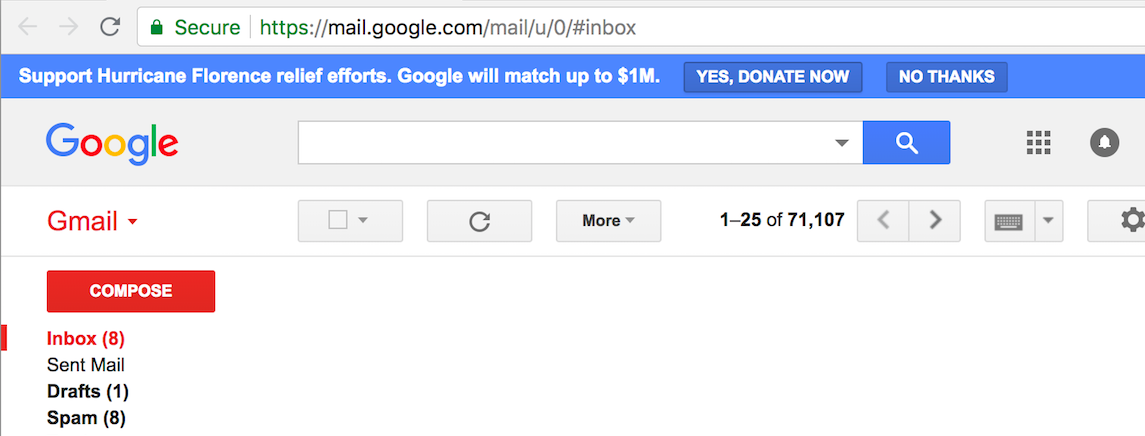
Google drew attention to its Hurricane Florence donation campaign with a banner that appeared on top of Gmail for some users. Google has matched donations for other disasters before, including Hurricane Irma and Hurricane Harvey last year. Italso raised money for humanitarian efforts crises, like a 2015 matching program for up to $5.5 million in donations to provide aid to refugees in Europe. For that campaign, it temporarily added a &Donate& button to its search homepage.
The company is partnering with non-profit Network for God to collect and distribute funds. All donations will be directed to the American Red Cross, which Google said it chose to work with &because of their strong track record and existing response in the region.&
Other tech companies helping with Hurricane Florence relief include Amazon, which enabled Alexa users to make donations by saying &Alexa, donate to Hurricane Florence disaster relief& and sent trucks with food and donated items to affected areas, and Apple, which donated $1 million to the American Red Cross. Airbnb also offered free rooms to people fleeing the hurricane.
- Details
- Category: Technology
Read more: Google will match up to $1M in donations for Hurricane Florence relief
Write comment (100 Comments)Below are excerpts from the most recent episode of the Flux podcast hosted by RRE Ventures principal Alice Lloyd George.
AMLG: Welcome back to the pod. I&m excited to be here withDr. Assaf Glazer. He is the co-founder and CEO ofNanita leading human analytics company that uses computer vision to help parents navigate their childsleep.
Essentially ita baby data collector that every sleep-deprived geek parent has dreamed of. A little background on Assaf: He got his Ph.D. at the Technion in Israel and was previously at Applied Materials as well as Wales where he worked on solutions for missile defense systems. Nanit was born here in New York at Cornell Tech [disclosure — RRE is a long-standing investor in the company.] Welcome Assaf itgreat to have you.
AG: Thank you for having me.
AMLG: I&ve got a stat here, that on average parents lose 44 days of sleep during the first year of their babylife and nearly 3 in 10 babies have problems sleeping at night. Those numbers sum up the nature of what you&re trying to solve, but can you lay out how you identified this problem and started the company
AG: It started for me as a parent. You have your baby, you arrive home and you see that your life has changed. Pretty quickly you understand what your number one concern is — sleep. You&re tired, you&re sleep deprived. You wake up during the night and do everything necessary to go back to sleep. You&re going to Google and going to friends. This is where Nanit comes in. We are giving you the information that will allow you to make better decisions for your child. Six years ago I had my first child, Udi. He was born when I was at the Technion. I&m a computer vision guy. Before I was at the Technion I worked at Applied Materials in the semiconductor industry, on a camera that you put above the silicon slices, to see them from a birdeye perspective.
AMLG: So you were doing computer vision for chip manufacturing — on the assembly lines, you&d look for errors in the chips
AG: Yes. And when my son was born I said, OK letdo process control for my baby.
AMLG: As if the baby was on an assembly line like a chip, just run some computer vision on it.
AG: Yeah. So I wrote a paper on background subtraction algorithms — how to find a foreground object differentiated from the background — and applied those algorithms to my baby. I went to my advisors at the Technion and told them, you know, I&ve found that my baby is moving 134 times on average at night. But what can you do with that I was looking at this data and I said sleep, sleep is what we need to solve here. I went to sleeping labs to try to understand sleep science. Then I moved as a postdoc to Cornell University where I joined the Runway Program, which aims to commercialize science.
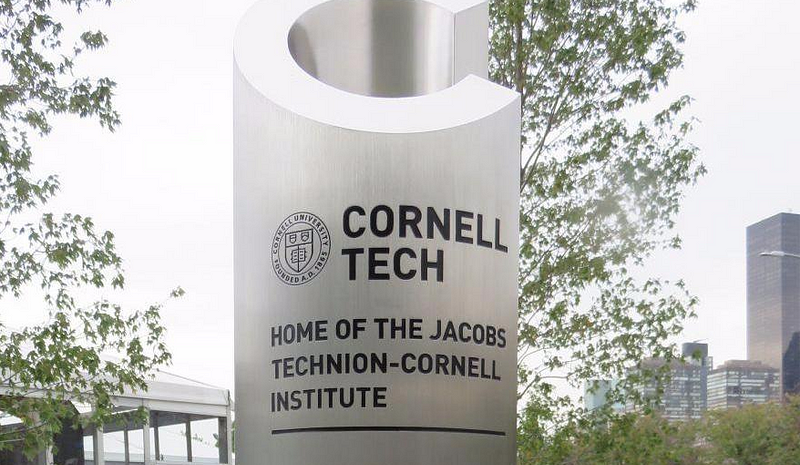
TheJacobs instituteis a joint venture between Cornell and the Technion-Israel Institute of Technology, operating as an independent entity within Cornell Tech. The Institute emphasizes a trans-disciplinary view of science and encourages translational research to serves the common good, through a set of industry-focused &hubs& that address contemporary needs.
AMLG: So you moved from Israel.
AG: I moved from Israel to where the customers are, which is New York.
AMLG: We also have the most anxious parents on the planet.
AG: Haha yes. I would say that New York is very inspiring. In terms of the culture, the diversity, ita great place to be.
AMLG: Tell me about the program at Cornell.
AG: It&sa joint venture for Cornell and Technion University. We were six postdocs that started in this program. They really helped me. Peretz Lavie the president of the Technion, hea sleep expert, a sleep guru I would say. He helped us reach out to experts around the world in sleep development and cognitive development. Then we developed Nanit with them.
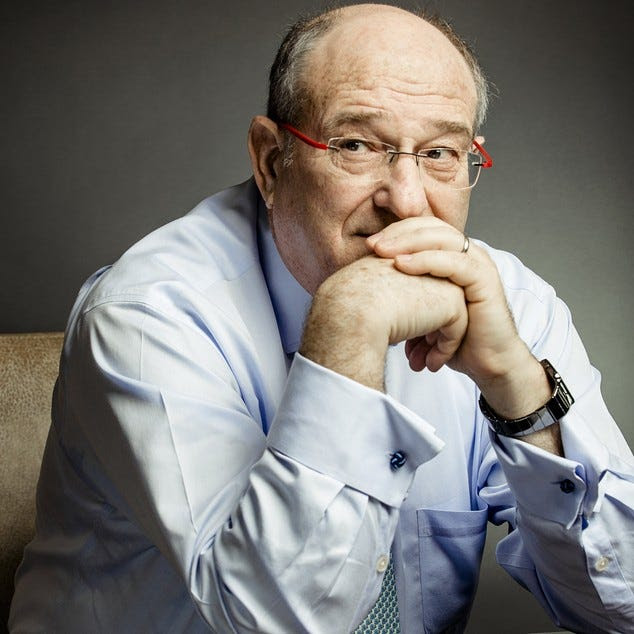
Dr Peretz Lavieis a world-renowned sleep expert and has been President of the Technion since 2009. Watch his interview on sleep research here.
AG: The development of infant sleep is fascinating. How we move between stages. How to differentiate between awake, asleep, deep sleep, REM sleep.
AMLG: Do babies have deep sleep and REM sleep as well
AG: When they are born ita bit of a mix. They have two states, awake and asleep. And over time —
AMLG: Like an on off switch.
AG: Haha ita bit more, but I&m not sure that we fully understand all the processes during the first few weeks. They dream much more than adults. And you see their architecture developing. One of the first experts that I worked with is Professor Avi Sadeh. I reached out to him through Peretz Lavie, as he developed the gold standard of how to measure sleep. The hypothesis is that movement is an indication of asleep and awake states, and with a camera you know much more. You draw the silhouette of the baby, you can detect the eyes. You can track the different parts of the body and you have better resolution. Today we measure sleep better than the state of the art medical devices. When you do it with a camera itpowerful because you can capture a lot of things around the sleep architecture. You build a picture. In our case we track the parent. When you look at this behavior — sleep and parent intervention patterns — you can give tips and recommendations for parents on how to improve, how to teach their baby to sleep on its own.
AMLG: As your user base gets bigger you&re going to have a lot of anonymized metadata that will give you insights—such as the more times you interrupt the babysleep or the more times you leave it alone, this is the effect. So is it the parent-child insights that you&re looking to get
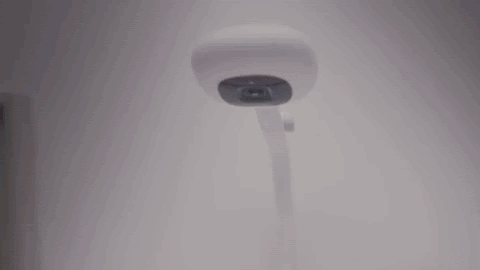 Meet Nanit [onYoutube]
Meet Nanit [onYoutube]AG: If you look at studies on sleep, we&re talking about hundreds top. With Nanit you are exposed tothousandsof babies sleeping in their natural environment. By looking at their behavior over time we learn new things. Sleep training is awareness and education. You&re building awareness with the data and the videos. We give parents information about how their week was in comparison to other babies of that age. There are no secrets — if you have the data you can use triggers to give tips to parents. For instance, I saw that your baby is capable of putting himself back to sleep during the night. Why don&t you wait one or two minutes before you enter the room.
AMLG: On the hardware side, can you share the journey there. You used to do manufacturing in the U.S. and you&ve moved that to China. What have you learned — how have margins improved How did you scale up volume What are your learnings about manufacturing
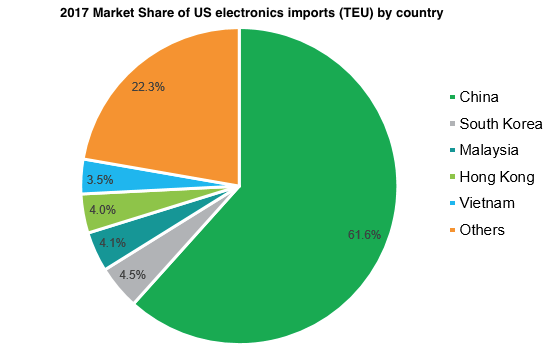
China continues to dominate U.S. electronics imports. Source: IHS Mark
AG: I&ll try to make it short. Itreally hard to build mass production lines in the U.S. for commodity consumer goods. From a labor perspective, prices in the U.S. are high. Over time it won&t exist in the U.S. as there is strong competition from China. But because it is a consumer product, having your designer, engineers and even the line close to you geographically is much more convenient. If you&re looking at the U.S. market, the engineers are also parents, which helps you explain the value proposition of your product. Itimportant that even the engineer who designs the circuit board understands what it means to have an LED that is strong enough above the bed. In general every engineer needs to have the product in mind when he does the design. Once we reached a stage that we had a line in the right yield and capacity, we did the transition to China. But it is expensive to work in this way, to start in the U.S. then move to China. There is no one recipe. Nanit also has an R-D center in Israel. Which means that now I&m working in three time zones. It is crazy. Most of our R-D is on the software side and on the hardware side we try to outsource when possible. If I had to choose I would choose Israel and the U.S.
AMLG: How have you found pulling those resources together and acquiring talent. You&ve obviously got a strategic advantage with the connection to Israel, but any insights on how you attract and retain the top talent, especially in machine learning
AG: Finding the right talent for your company is a search problem. The world is big and in different parts of the world there are different types of talent. In Israel there is great talent for backend engineers and computer vision, and we hire those people in Israel. In the U.S. theregreat talent in marketing, sales, business development, brand development, human centric design — for those, New York is a great place to be. In China you find talent related to manufacturing and they are very good at it. In the past it was hard to build a company in this way. But the world changed. The world changed in the sense of how we communicate. The only thing that hasn&t been solved yet is time zones. If everyone slept at the same time that would help. But besides the time zones, technology today can solve a lot of problems. Nanit couldn&t exist a couple of years ago when we didn&t have this.
AMLG: Right you wouldn&t have been able to do it all in Israel or all in New York or all in China. What about on the machine learning side — what is going on on a more macro level there
AG: Deep learning and convolutional neural networks are amazing tools that help us do things we weren&t able to do before. Thanks to deep learning, today I can tell you the babyposition in the crib better than the human eye. But what happened is that it was so disruptive that many other parts of the computer vision field, you started seeing them less and less at conferences. Add to this the fact that it generates lots of value for companies like Google, Amazon, Microsoft —
AMLG: So machine learning has become dominated by big platforms like Google and Apple, and perhaps research for researchsake is a valuable thing and not just having it all steered towards revenue or commercial applications. You&re saying itimportant to have pure research
AG: This is what research is about. It should be pure.
AMLG: Do you know Gary MarcusHe came on this podcast last year, and his point about these companies is that when you&re a hammer everything looks like a nail. When you have a ton of data — you&re Google or Facebook — everything looks like you should apply deep learning to it. But thattheir bias and perhaps it skews out other approaches to machine learning.
AG: Also I would say it becomes a commodity over time. I believe the next innovation will be around behavioral analysis, which is the next level of computer vision. We are working on research collaborations that study small twitches of a baby, which could be an indicator of neurological disorders. There is a next level of behavioral neuroscience, ita fascinating field that is going to develop over the next couple of years.
AMLG: So you have this background in Israeli defense where you worked on missile defense systems. Can you share anything about that or how itinformed what you&re doing now Working in that environment is quite different than having a startup in New York.
AG: I was in a foundational team in the Nineties for a new defense system. It took me a couple of years to understand that I was a beta tester. They used me to understand the human factor. How to communicate between operators, how to design the screens. I cannot explain how much this experience has helped me to go through the design phase for Nanit. How to do design sprints with parents, how to design the screens. The army is an amazing human resource filter that allocates hundreds of thousands of teenagers to specific positions and trains them in a short time and gives them practical experience. They are doing an amazing job. There are mistakes of course, but they took me and others and decided this is what you are going to do. They gave me tools for things that in the future were of great benefit to me.
AMLG: How does working on missile defense UX or chip manufacturing compare to baby monitoring
AG: Ha well I continue to serve as a major in reserve. But in life I decided that I wanted to make a shift to deal with more human problems. What is nice about semiconductors is that they are designed by humans not by nature. Babies were designed by nature, which is more complex. When you have a blueprint you know exactly what you&re looking for, what kind of patterns. Then you can reach a level of analysis, of process control that is much higher. But the challenges with babies you know is —
AMLG: They&re more of a mystery.
AG: Ita lot of mystery. But my philosophy is to build the scientific fundamentals, the building blocks, and on top of that you think about how to make it approachable for the consumer space and how to build a value proposition. You start with science not marketing statements. This is where you start.
AMLG: A world of more ambient data capture where you&re continually monitored. Which feeds into preventative medicine. Obviously therea lot of people that get nervous about that, though itthe way the whole world is going, we&re going to more data and itgoing to serve us. But as you push that conversation forward, do you feel like therechallenges in terms of getting people used to the idea
AG: You need to do it in a responsible way. But we can live a much better life. We will have better parenting experiences, sleep better at night. Even know things about ourselves that we didn&t know before.
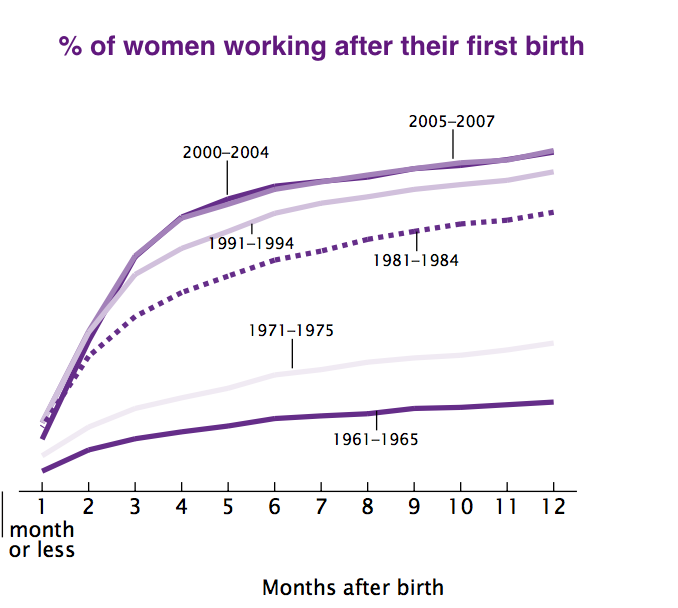
U.S Census Bureau Research 1961-2008
Further reading:
- Details
- Category: Technology
Read more: Solving the mystery of sleep
Write comment (91 Comments)Page 4140 of 5614

 10
10





